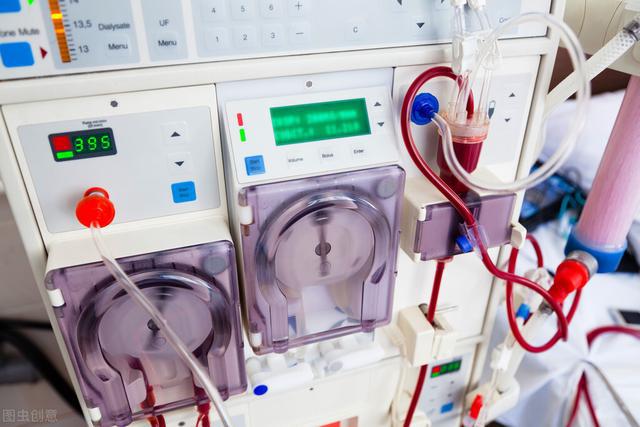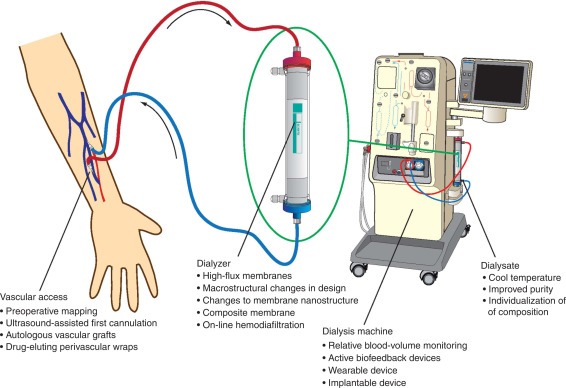The global hemodialysis market is expanding rapidly, driven by a confluence of factors including the rising prevalence of chronic kidney disease (CKD), technological advancements, increasing healthcare expenditure, and growing awareness of renal health. This growth is particularly pronounced in the Asia-Pacific region, where demographic changes and healthcare reforms are fueling demand. This market encompasses a diverse array of products and services, from dialysis machines and consumables to comprehensive care services provided by specialized clinics and hospitals. Major players in the hemodialysis market are continually innovating and expanding to capture a larger share of this burgeoning market.
Market Overview
Hemodialysis is a life-sustaining treatment for patients with end-stage renal disease (ESRD) and severe CKD, wherein a machine filters waste products and excess fluids from the blood. The global hemodialysis market was valued at approximately $80.26 billion in 2023 and is projected to reach $122.51 billion by 2034, growing at a CAGR of around 4.2% during the forecast period(Expert Market Research) (GlobeNewswire).
Key Market Drivers
1. Increasing Prevalence of CKD and ESRD:
- CKD and ESRD cases are rising globally due to lifestyle-related diseases like diabetes and hypertension. The number of patients requiring dialysis is growing, driving demand for hemodialysis services(Expert Market Research) (GlobeNewswire).
2. Technological Advancements:
- Innovations in dialysis machines and consumables are enhancing the efficiency and safety of hemodialysis. Advanced technologies such as high-flux dialysis and hemodiafiltration are gaining popularit(Expert Market Research) (GlobeNewswire).
3.Healthcare Policies and Infrastructure:
- Governments are implementing policies to improve access to dialysis treatments. Increased healthcare spending and the establishment of new dialysis centers are bolstering market growth(Expert Market Research) (GlobeNewswire).
Market Segmentation
The hemodialysis market can be segmented by product type, modality, end-user, and region.
1.By Product Type:
- Equipment: Dialysis machines, water treatment systems, and other related equipment.
- Consumables: Dialyzers, bloodlines, catheters, and other disposables.
2.By Modality:
- Conventional Hemodialysis: Typically performed three times a week.
- Short Daily Hemodialysis: Conducted more frequently but for shorter durations.
- Nocturnal Hemodialysis: Performed overnight, allowing for longer treatment sessions.
3.By End-User:
- Hospitals: Major users of hemodialysis services, particularly for severe cases and emergencies.
- Dialysis Centers: Specialized facilities offering comprehensive dialysis care.
- Home Dialysis: Increasingly popular for its convenience and flexibility.
Regional Insights
The Asia-Pacific region is expected to witness significant growth in the hemodialysis market. Countries like China, India, Japan, and Southeast Asian nations are investing heavily in healthcare infrastructure and dialysis services(BlueWeave Consultin) (Research&Markets).
- China: Rapid economic growth and a large aging population are driving the hemodialysis market. The country is investing in healthcare infrastructure and expanding dialysis services to meet growing demand(Research&Markets).
- India: The rising incidence of diabetes and hypertension is leading to a higher prevalence of CKD, driving the demand for hemodialysis. The market is expanding with the establishment of new dialysis centers and improved access to treatment(Research&Markets).
- Japan: With one of the highest aging populations in the world, Japan has a substantial demand for hemodialysis. The country’s focus on technological advancements in medical devices is enhancing the efficiency and safety of hemodialysis treatments(Research&Markets).
- Southeast Asia: Countries like Indonesia, Thailand, and Malaysia are seeing rapid growth in the hemodialysis market due to increasing healthcare investments and the establishment of new dialysis centers(IMARC).
Major Market Players
Several key players dominate the global hemodialysis market, each contributing to advancements in technology and expansion of services.
1.Fresenius Medical Care AG & Co. KGaA:
- Fresenius is the largest provider of dialysis products and services worldwide. The company offers a comprehensive range of hemodialysis machines, dialyzers, and related products. It operates a vast network of dialysis clinics globally(Research&Markets).
- Recent Developments: Fresenius introduced the 5008X hemodiafiltration system in the United States, enhancing the efficiency and outcomes of dialysis treatments(Future Insights).
2.DaVita Inc.:
- DaVita is a leading provider of dialysis services, operating numerous dialysis centers primarily in North America. The company focuses on delivering high-quality patient care and has been expanding its presence internationally(Research&Markets).
- Recent Developments: DaVita has been investing in home dialysis programs to provide more flexible treatment options for patients(Research&Markets).
3.Baxter International Inc.:
- Baxter is a major player in the global dialysis market, offering a range of hemodialysis and peritoneal dialysis products. The company is known for its innovative dialysis solutions and has a strong presence in both developed and emerging markets(Future Insights).
- Recent Developments: Baxter has been focusing on developing new technologies for home dialysis, aiming to improve patient convenience and outcomes(Future Insights).
4.B. Braun Melsungen AG:
- B. Braun provides a wide range of dialysis products, including machines, dialyzers, and consumables. The company is committed to advancing dialysis technology and improving patient care through continuous innovation(Research&Markets).
- Recent Developments: B. Braun has been expanding its product portfolio with new dialysis machines designed to enhance treatment efficacy and patient comfort(Future Insights)
5.Nipro Corporation:
- Nipro is a leading manufacturer of dialysis products, including hemodialysis machines, dialyzers, and bloodlines. The company is focused on providing high-quality, cost-effective dialysis solutions(Future Insights)
- Recent Developments: Nipro has been investing in research and development to introduce new products that improve the safety and efficiency of dialysis treatments(Future Insights)
Emerging Trends
1.Home Hemodialysis:
- Home hemodialysis is becoming increasingly popular due to its convenience and the ability to provide more frequent and flexible treatment options. Advances in portable and easy-to-use dialysis machines are facilitating this shift(BlueWeave Consultin) (IMARC).
2.Technological Innovations:
- Innovations in hemodialysis technology, such as high-flux dialysis, hemodiafiltration, and wearable dialysis devices, are enhancing treatment outcomes and patient quality of life(BlueWeave Consultin) (IMARC).
3.Telemedicine and Remote Monitoring:
- The integration of telemedicine and remote patient monitoring technologies is improving the management of dialysis patients, allowing for better real-time monitoring and personalized treatment plans(Future Insights) (IMARC).
4.Sustainability and Environmental Considerations:
- There is a growing focus on sustainability in the hemodialysis industry. Providers are exploring eco-friendly practices and efficient water and energy management solutions to reduce the environmental impact of dialysis treatments(Future Insights)
Challenges
Despite the positive outlook, the hemodialysis market faces several challenges:
1.High Costs:
- The cost of hemodialysis treatment is high, posing a financial burden on patients and healthcare systems, especially in low- and middle-income countries(Future Insights).
2.Limited Access in Rural Areas:
- Access to dialysis treatment is limited in rural and remote areas due to inadequate healthcare infrastructure and a shortage of trained healthcare professionals(Future Insights) (Research&Markets).
3.Patient Compliance:
- Ensuring patient compliance with treatment schedules and dietary restrictions remains a challenge, impacting the effectiveness of hemodialysis(Future Insights).
Future Outlook
The global hemodialysis market is poised for significant growth, driven by rising CKD prevalence, technological advancements, and expanding healthcare infrastructure. Key players are focusing on innovation and expanding their presence in emerging markets to capture growth opportunities. The shift towards home hemodialysis, coupled with advances in telemedicine and remote monitoring, is expected to transform patient care and improve treatment outcomes. While challenges such as high costs and limited access in rural areas persist, ongoing efforts to address these issues are likely to enhance the market’s growth prospects in the coming years.
In summary, the hemodialysis market represents a dynamic and rapidly evolving sector within the healthcare industry, characterized by technological innovation, expanding global reach, and a strong focus on improving patient outcomes and accessibility.
Dialysis Blood Tube Assembly Line

